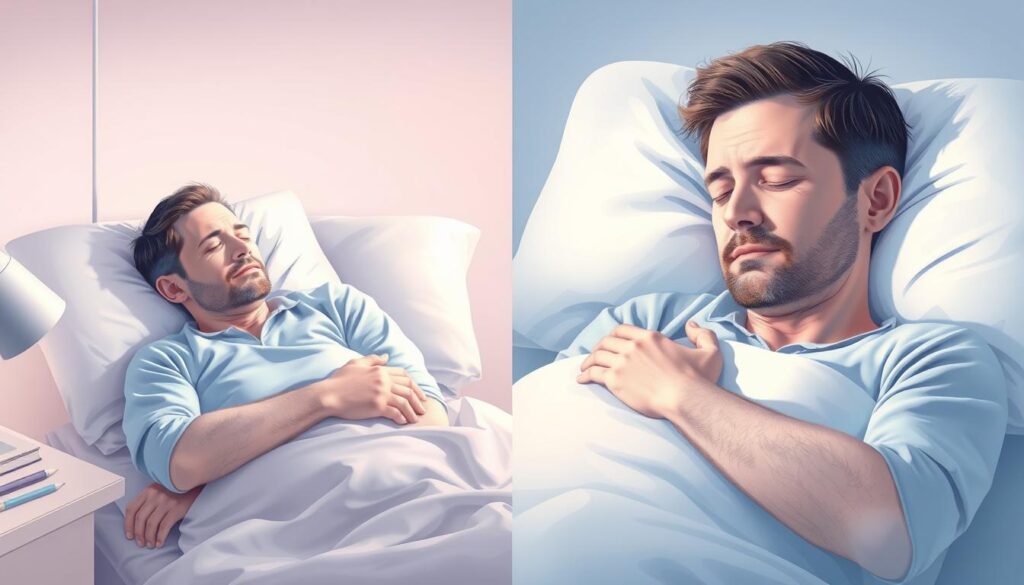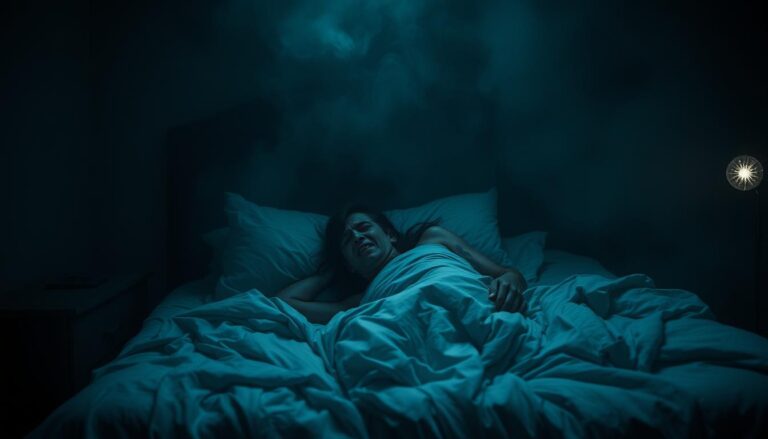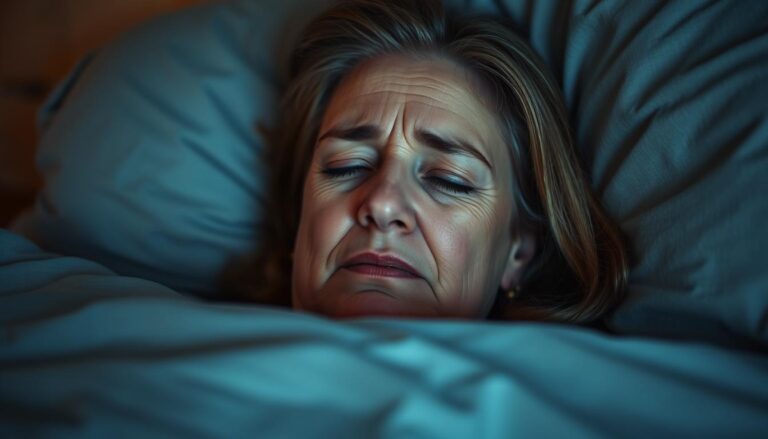
One in 15 Americans has sleep apnea, but 80% don’t know they do. Obstructive sleep apnea (OSA) affects 22 million in the U.S. Central sleep apnea (CSA) is rarer but just as risky. This comparison shows how these two types share symptoms but have different causes and treatments.
OSA happens when your throat blocks your airway. CSA occurs when your brain forgets to tell your muscles to breathe. Both need special treatments to fix their problems. Knowing the difference is crucial for your health.
Key Takeaways
- Over 22 million Americans have sleep apnea, but 80% remain undiagnosed.
- OSA is the most common form, caused by airway blockages during sleep.
- CSA involves the brain’s failure to regulate breathing, linked to heart issues or medications.
- Both types raise risks for heart disease, diabetes, and cognitive decline if untreated.
- CPAP and lifestyle changes help manage symptoms, but treatments vary based on the sleep apnea type.
Understanding Sleep Apnea Types and Their Impact on Your Health
Knowing the sleep apnea types helps you understand your risks. Central sleep apnea vs obstructive sleep apnea have different causes but share symptoms like snoring or fatigue. Both types disrupt sleep, raising risks for heart disease and diabetes.
What Is Obstructive Sleep Apnea?
Obstructive sleep apnea (OSA) happens when throat muscles relax, blocking airflow. You might stop breathing for over 10 seconds, 5+ times hourly. Risk factors include obesity, smoking, and nasal congestion. Over 25 million Americans have OSA, with men 2–3 times more likely than women to be affected.
What Is Central Sleep Apnea?
Central sleep apnea (CSA) occurs when your brain fails to send signals to breathe. It’s linked to heart failure, stroke, or certain medications. CSA risk factors include older age and neurological disorders. Unlike OSA, CSA episodes often lack loud snoring but still disrupt sleep cycles.
The Prevalence of Each Type in the US Population
| Type | Risk Factors | Prevalence |
|---|---|---|
| OSA | Obesity, smoking, nasal congestion | Affects ~25 million Americans |
| CSA | Heart failure, stroke, medications | Rare but critical to diagnose |
OSA is far more common, but both types demand attention. Central sleep apnea risk factors like heart issues require early detection. Recognizing differences helps you seek the right care.
Central vs Obstructive Sleep Apnea Differences: Symptoms and Causes
Understanding central sleep apnea symptoms and obstructive sleep apnea causes is key. These conditions affect sleep but in different ways. For instance, obstructive sleep apnea (OSA) blocks airways, while central sleep apnea is due to brain issues.

- Symptoms:
- OSA: Loud snoring, gasping, morning headaches, and feeling tired during the day.
- CSA: Shortness of breath when waking, trouble sleeping, and less snoring.
- Causes:
- OSA: Physical blockages in the airway, often due to obesity, nasal issues, or sleeping on your back.
- CSA: Often caused by heart failure, high altitude, or opioid use affecting brain signals.
Central sleep apnea affects 2-4% of people, while OSA impacts up to 24% of men and 9% of women. If you’re tired all the time or notice breathing pauses, you might be at risk. Obesity increases OSA risk, while heart issues or medication side effects might suggest CSA. Spotting these central vs obstructive sleep apnea differences early is crucial. It helps you get the right treatment before serious problems like heart rhythm issues occur.
Diagnosing Your Sleep Apnea: Tests and Procedures
Figuring out if you have central vs obstructive sleep apnea diagnosis needs special tests. Knowing the type is crucial for the right treatment. Here’s how to find out what you have.

Sleep Studies and Polysomnography
A lab-based sleep apnea comparison starts with polysomnography (PSG). This test tracks your sleep in a lab. It looks at:
- Brain waves, oxygen levels, and heart rate
- Breathing and leg movements
New tools like the 3D-CNN model can spot apnea types with 95% accuracy. It looks at breathing patterns. This is especially useful for central sleep apnea symptoms like sudden breathlessness at night.
Home Sleep Apnea Testing Options
| Test Type | What’s Measured | Pros | Cons |
|---|---|---|---|
| Lab PSG | Oxygen levels, brain activity | Accurately distinguishes apnea types | $400+ cost in Canada |
| Home Tests | Breathing effort and oxygen | Convenient, affordable | Risk of missing central apnea signs |
The Role of Medical History in Diagnosis
Doctors ask about symptoms like:
- Awakening gasping for air
- Insomnia or morning headaches
These clues help spot central sleep apnea symptoms versus obstructive causes. Sharing medication use or heart conditions is key. Central apnea often links to health issues.
When to See a Sleep Specialist
If home results are unclear or you have severe symptoms like chronic fatigue, see a sleep specialist. They might suggest advanced imaging or heart tests. Don’t wait if symptoms keep coming back, even with lifestyle changes.
Treatment Approaches for Different Sleep Apnea Types
Choosing the right central vs obstructive sleep apnea treatment depends on your diagnosis. Both types share some therapies but need tailored approaches. Let’s explore options that target your specific needs.

For obstructive sleep apnea management, CPAP machines are key. They deliver steady air pressure to keep airways open. BiPAP and ASV adjust pressure for breathing patterns. ASV adapts to your breaths, making it ideal for central sleep apnea (CSA) linked to heart conditions.
- CPAP: First-line therapy for OSA; customizable for CSA in some cases.
- ASV: Monitors breathing and adjusts pressure in real time for CSA patients.
- BiPAP: Uses two pressure settings for easier exhalation, aiding those with heart failure or weak breathing muscles.
Lifestyle changes improve outcomes for both types. Losing weight, avoiding alcohol before bed, and sleeping on your side reduce central sleep apnea risk factors like heart issues or opioid use. Quitting smoking and managing nasal congestion also help.
Medications play a smaller role. For CSA, diuretics or acetazolamide may reduce apneas. OSA patients with heart failure might try nocturnal oxygen therapy. Surgery like uvulopalatopharyngoplasty (UPPP) targets OSA’s physical airway blockages.
Emerging therapies offer hope. A recent study highlighted phrenic nerve stimulators, which improve breathing by stimulating the diaphragm.
“Phrenic nerve stimulation reduced disease severity by 30% in CSA patients,” said a 2023 trial, showing promise for those with heart-related CSA.
Avoid ASV if you have heart failure—it’s linked to higher mortality in some cases.
Treatment plans must align with your health. Work with a specialist to balance devices, lifestyle, and emerging options. Your path to better sleep starts with a tailored strategy.
Conclusion: Managing Your Sleep Apnea for Better Health
Understanding sleep apnea starts with knowing its types. Obstructive sleep apnea (OSA) often needs lifestyle changes and CPAP devices. Central sleep apnea (CSA) might need heart or brain issue fixes. Getting the right diagnosis is crucial.
Snoring loudly or waking up gasping means you might have OSA. CSA symptoms include sudden awakenings and shortness of breath. Both types can lead to heart disease and high blood pressure. Early treatment is important.
Managing OSA includes losing weight, avoiding alcohol, and using CPAP machines. CSA treatment might involve ASV or changing medications. Obesity is a big risk for OSA, but treatments are available. BiPAP devices help 70% of OSA patients when CPAP fails.
Men over 60 face higher CSA risks. Smoking increases OSA risk by 30%. Quitting smoking can help. Heart failure or opioid use also raises CSA risk. See a sleep specialist for a review.
Ignoring sleep apnea can harm your health long-term. Both types need a personalized plan. Your doctor can suggest phrenic nerve stimulation for CSA or lifestyle changes for OSA. Stay proactive and follow up regularly for better sleep and health.











